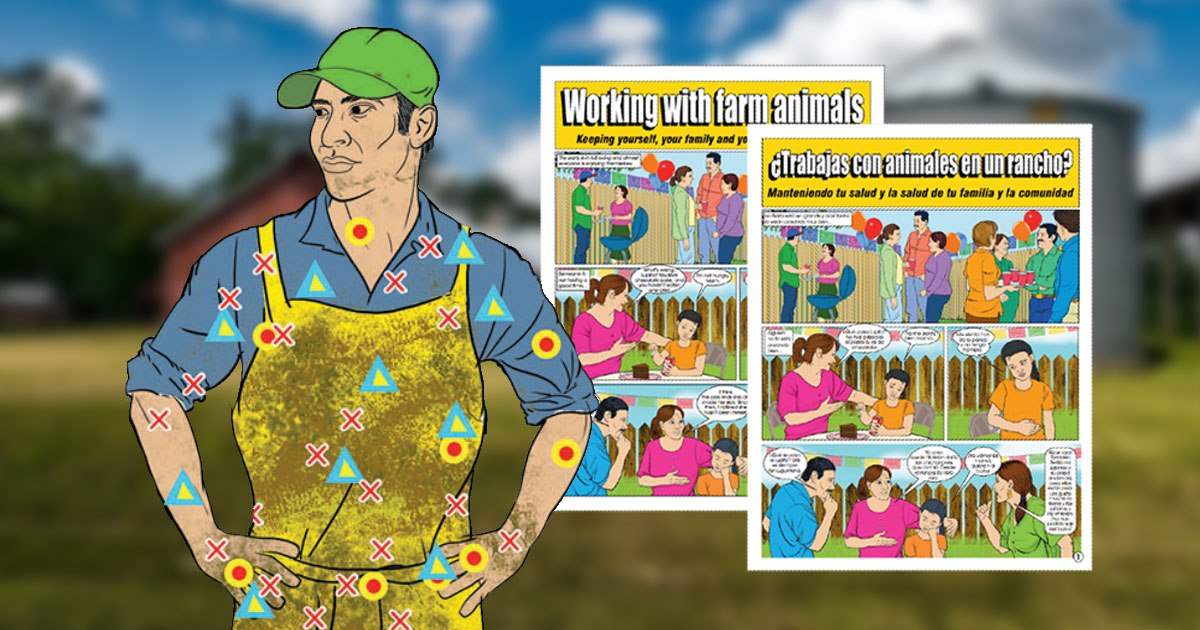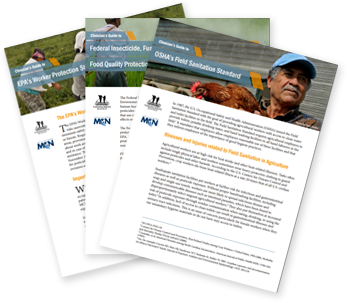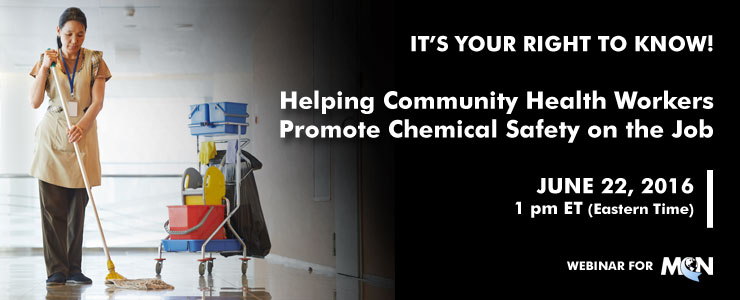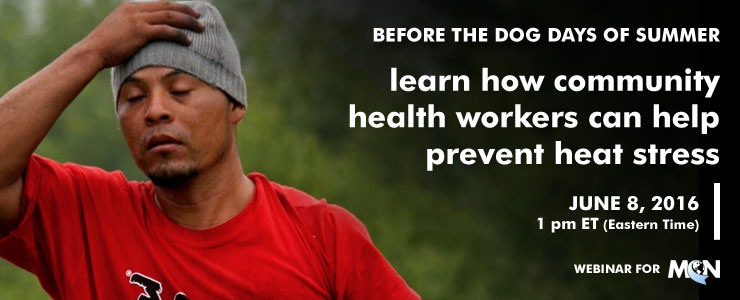HRSA’s new COVID-19 FAQs give some overview on the health center requirements around emergency preparedness as well as recommendations for communications from health centers.
Application Deadline: 04/15/2018 at 5 pm CST
The Underserved Occupational Populations Section of ACOEM is sponsoring one $1,000 scholarship to qualified residents and medical students interested in making significant contributions to the field of underserved occupational medicine.The scholarship was established in honor of Joseph A. Fortuna, MD, FACOEM who founded the Underserved Occupational Populations Section of ACOEM and who was a tireless supporter of underserved workers and their families.
- JAF Memorial Scholarship to AOHC.3.pdf (284.44 KB)
This new poll, taken by Migrant Clinicians Network in January and February 2018, reflected the experiences of clinical staff from 26 states across the country. Respondents came from every corner of the clinic; occupations listed include Physician, Executive Director, Dental Assistant, Outreach Specialist, Therapist, Community Health Worker, Registered Nurse, and 24 other occupations. The poll follows up on MCN’s 2017 poll, in which 63 percent of respondents indicated that immigrant and mobile patients’ attitudes and feelings toward health care access had changed.
- Poll Results February 2018.pdf (92.89 KB)
"The Global Report on Internal Displacement presents the latest information on internal displacement worldwide caused by conflict, violence and disasters."
"These materials are designed to be simple and useful in helping physicians and health-care professionals to meet the needs of their patients who may be undocumented or suffering stresses related to close family or community members being undocumented. While there are many toolkits being developed, we hope that these materials might be very easy to use and enable the physician or other health-care professional to address the most immediate needs of such patients."
Offers basic screening questions, common occupations and ailments associated with them, as well as recommended treatment. Also includes sample letters from clinicians to employers for restricted work.
This resource offers training for community based organizations and workers in the aftermath of natural disasters. It includes educational materials as well as trainer guides and tools.
Blog post from the U.S. Department of Labor highlighting common hazards during hurricane cleanup as well as links to additional readings.
Information on keeping food and water safe for consumption and best hygiene practices in the face of disasters.
Offers tips about potential hazards and protective strategies during disaster cleanup.
This page highlights important tools for clinicians as well as diagnoses to consider when caring for disaster-affected patients.
United for Puerto Rico is an initiative brought forth by the First Lady of Puerto Rico, Beatriz Rosselló, in collaboration with the private sector, with the purpose of providing aid and support to those affected in Puerto Rico by the passage of Hurricane Irma and Hurricane María. 100% of the proceeds will go to helping the victims afteced by these natural disasters in Puerto Rico.
This site includes various helpful links including information on health hazards, mold remediation, respirator use, and related policy information.
Comprehensive flood information including links to preparedness and response/recovery pages.
Comprehensive hurricane information including links to preparedness and response/recovery pages.
"To assist health centers in obtaining Federal Emergency Management Agency (FEMA) funding for damaged or destroyed facilities, Capital Link has developed Hurricane Recovery Resources for Health Centers, supported by the Health Resources and Services Administration."
"The Human Diagnosis Project (also referred to as "Human Dx" or "the Project") is a worldwide effort created with and led by the global medical community to build an online system that maps the best steps to help any patient. By combining collective intelligence with machine learning, Human Dx intends to enable more accurate, affordable, and accessible care for all."
A resource by the CDC highlighting the symptoms and signs of carbon monoxide poisoning, which is often a cause of illness and death after a natural disaster.
"Carbon monoxide (CO) is an odorless, colorless, poisonous gas that can cause sudden illness and death if present in sufficient concentration in the ambient air. When power outages occur during emergencies such as hurricanes or winter storms, the use of alternative sources of fuel or electricity for heating, cooling, or cooking can cause CO to build up in a home, garage, or camper and poison the people and animals inside." - CDC
California's Medical Supervision Program is a biomonitoring program that measures cholinesterase activity in bloog samples from agricultural workers. Employers are required by law to contract with physicians who have registered for this program, all of whom are included in this list.
Safety and Health Practicesfor Nail Salon Workers and a Training Guide for Nail Salon Worker Safety and Health Outreach Program
- Best_Practices_HOPE.pdf (230 KB)
- Trainer_Guide_HOPE.pdf (1.34 MB)
Includes EPA manual "How to Comply With the 2015 Revised Worker Protection Standard For Agricultural Pesticides - What Owners and Employers Need To Know" and an excerpt specifically for clininicians regarding medical evaluation and respirator fit test. See also the medical evaluation questions in English and Spanish.
This 90-minute webinar was created for physicians, nurses, and other health professionals who treat and case manage patients with active TB. The webinar introduced the 2016 Official American Thoracic Society/Centers for Disease Control and Prevention/Infectious Diseases Society of America Clinical Practice Guidelines: Treatment of Drug-Susceptible Tuberculosis. This training highlighted the guidelines development process, the key changes in recommendations, and discussed the evidence supporting the changes. The webinar was originally presented on November 4, 2016. This training was jointly sponsored by all 5 RTMCCs.
Diabetes HealthSense provides easy access to resources to help you live well and meet your goals—whether you have diabetes or are at risk for the disease. Available in English.

Libro cómic educativo bilingüe sobre cómo prevenir las enfermedades zoonóticas. Desarrollado por MCN en colaboración con la Universidad Estatal de Ohio.
- Working with farm animals_1.pdf (13.33 MB)
- Trabajos con animales en un rancho_1.pdf (13.31 MB)

MCN y Farmworker Justice ofrecen estas guías para ayudar a los médicos en la comprensión de regulaciones de salud y seguridad de los campesinos. Información de los Estándares de Saneamiento de la Administración de Seguridad y Salud Ocupacional (OSHA) para los campos; la Ley Federal de Insecticidas, Fungicidas y Rodenticidas (FIFRA) regulado por la Agencia de Protección Ambiental (EPA); la Ley de la Protección de la Calidad de los Alimentos (FQPA) también regulado por el EPA; y el estándar de protección del trabajador (WPS) establecido por el EPA.
- OSHA's Field Sanitation Standard Clinician's Guide.pdf (747.53 KB)
- FIFRA FQPA Clinician's Guide.pdf (287.9 KB)
- WPS Clinician's Guide.pdf (843.35 KB)

MCN and Farmworker Justice offer these guides to assist clinicians in understanding farmworker health and safety regulations. OSHA’s Field Sanitation Standard; EPA's Federal Insecticide, Fungicide, and Rodenticide Act (FIFRA); EPA's Food Quality Protection Act (FQPA); EPA’s Worker Protection Standard (WPS).
- OSHA's Field Sanitation Standard Clinician's Guide.pdf (747.53 KB)
- FIFRA FQPA Clinician's Guide.pdf (287.9 KB)
- WPS Clinician's Guide.pdf (843.35 KB)
The 1999–2013 United States Cancer Statistics (USCS): Incidence and Mortality Web-based Report includes the official federal statistics on cancer incidence from registries that have high-quality data, and cancer mortality statistics. It is produced by the Centers for Disease Control and Prevention (CDC) and the National Cancer Institute (NCI). This report shows that in 2013, 1,536,119 Americans received a new diagnosis of invasive cancer, and 584,872 Americans died of this disease (these counts do not include in situ cancers or the more than 1 million cases of basal and squamous cell skin cancers diagnosed each year).
This year’s report features information on invasive cancer cases diagnosed during 2013, the most recent year of incidence data available, among residents of 49 states, six metropolitan areas, and the District of Columbia—geographic areas in which about 99% of the U.S. population resides. Incidence data are from CDC’s National Program of Cancer Registries (NPCR) and NCI’s Surveillance, Epidemiology, and End Results (SEER) Program. Data from population-based central cancer registries in these states and metropolitan areas meet the criteria for inclusion in this report.
The report also provides cancer mortality data collected and processed by CDC’s National Center for Health Statistics. Mortality statistics, based on records of deaths that occurred during 2013, are available for all 50 states and the District of Columbia.
The report also includes incidence rates and counts for Puerto Rico for 2009 through 2013 by sex and age, as well brain tumor and childhood cancer data.
USCS data are presented in the following applications—
- https://nccd.cdc.gov/uscs/?s_cid=govD_USCS2013_1
- http://links.govdelivery.com/track?type=click&enid=ZWFzPTEmbWFpbGluZ2lkPTIwMTYwNzA2LjYxMjE2OTcxJm1lc3NhZ2VpZD1NREItUFJELUJVTC0yMDE2MDcwNi42MTIxNjk3MSZkYXRhYmFzZWlkPTEwMDEmc2VyaWFsPTE3MDg5NzQwJmVtYWlsaWQ9dGx5b25zQG1pZ3JhbnRjbGluaWNpYW4ub3JnJnVzZXJpZD10bHlvbnNAbWlncmFudGNsaW5pY2lhbi5vcmcmZmw9JmV4dHJhPU11bHRpdmFyaWF0ZUlkPSYmJg%3D%3D&101=&https%3A%2F%2Fnccd_cdc_gov%2Fuscs%2F%3Fs_cid=govD_USCS2013_2
- http://links.govdelivery.com/track?type=click&enid=ZWFzPTEmbWFpbGluZ2lkPTIwMTYwNzA2LjYxMjE2OTcxJm1lc3NhZ2VpZD1NREItUFJELUJVTC0yMDE2MDcwNi42MTIxNjk3MSZkYXRhYmFzZWlkPTEwMDEmc2VyaWFsPTE3MDg5NzQwJmVtYWlsaWQ9dGx5b25zQG1pZ3JhbnRjbGluaWNpYW4ub3JnJnVzZXJpZD10bHlvbnNAbWlncmFudGNsaW5pY2lhbi5vcmcmZmw9JmV4dHJhPU11bHRpdmFyaWF0ZUlkPSYmJg%3D%3D&102=&https%3A%2F%2Fnccd_cdc_gov%2FDCPC_INCA%2F%3Fs_cid=govD_USCS2013_3
- http://links.govdelivery.com/track?type=click&enid=ZWFzPTEmbWFpbGluZ2lkPTIwMTYwNzA2LjYxMjE2OTcxJm1lc3NhZ2VpZD1NREItUFJELUJVTC0yMDE2MDcwNi42MTIxNjk3MSZkYXRhYmFzZWlkPTEwMDEmc2VyaWFsPTE3MDg5NzQwJmVtYWlsaWQ9dGx5b25zQG1pZ3JhbnRjbGluaWNpYW4ub3JnJnVzZXJpZD10bHlvbnNAbWlncmFudGNsaW5pY2lhbi5vcmcmZmw9JmV4dHJhPU11bHRpdmFyaWF0ZUlkPSYmJg%3D%3D&103=&https%3A%2F%2Fnccd_cdc_gov%2FStateCancerFacts%2F%3Fs_cid=govD_USCS2013_4

DATE RECORDED: June 22, 2016
PRESENTED BY: Kerry Brennan
This material will be produced under grant number SH-27640-15-60-F-48-SH5 from the Occupational Safety and Health Administration, U.S. Department of Labor. It will not necessarily reflect the views or policies of the U.S. Department of Labor, nor does mention of trade names, commercial products, or organizations imply endorsement by the U.S. Government.

DATE RECORDED: June 8, 2016
PRESENTED BY: Juliana Simmons, MSPH, CHES
This material will be produced under grant number SH-27640-15-60-F-48-SH5 from the Occupational Safety and Health Administration, U.S. Department of Labor. It will not necessarily reflect the views or policies of the U.S. Department of Labor, nor does mention of trade names, commercial products, or organizations imply endorsement by the U.S. Government.
- https://youtu.be/qcCci3GQs04
- http://www.migrantclinician.org/
- https://www.osha.gov/SLTC/heatstress/prevention.html
- http://www.farmworkerjustice.org/sites/default/files/FJpesticidetrainingspanish2016.pdf
- https://www.osha.gov/SLTC/heatstress/index.html
- https://www.osha.gov/SLTC/heatillness/index.html
- https://www.osha.gov/SLTC/heatstress/industry_resources.html
- http://www.dir.ca.gov/dosh/heatIllnessQA.html
- http://www.lni.wa.gov/Safety/Topics/AtoZ/HeatStress/
- http://en.hesperian.org/hhg/Workers%27_Guide_to_Health_and_Safety:Dangers_from_heat
- http://www.naplesnews.com/news/crime/report-farmworkers-death-should-have-been-prevented-2738c212-4e00-109c-e053-0100007fd972-363310521.html
- http://www.cdc.gov/niosh/topics/heatstress/heatrelillness.html